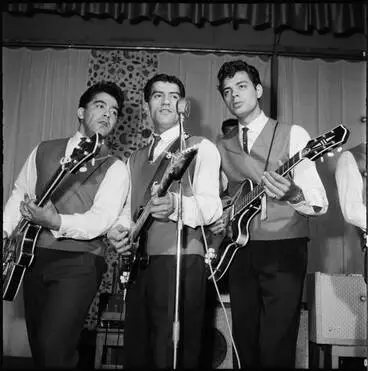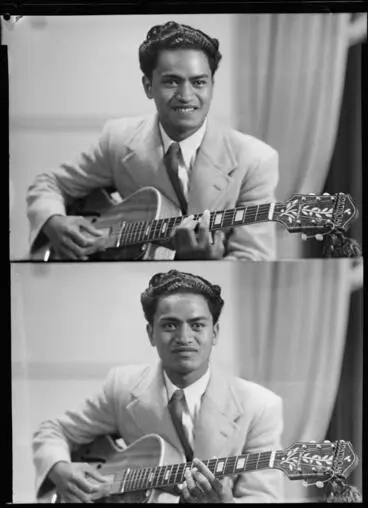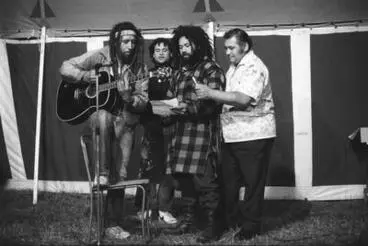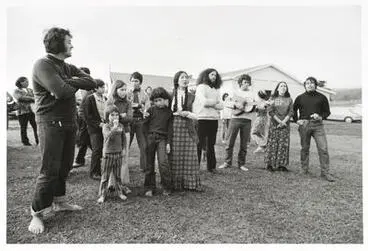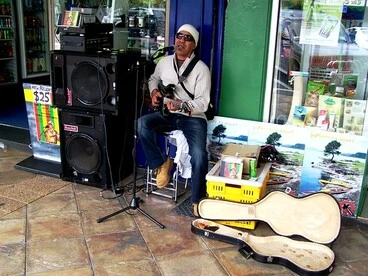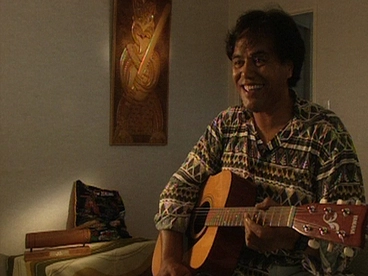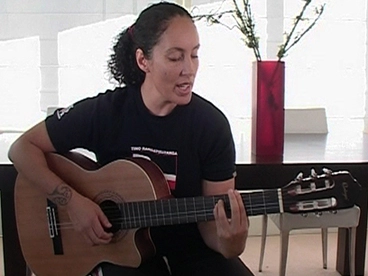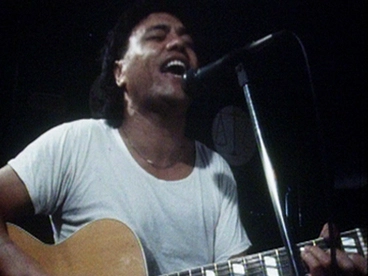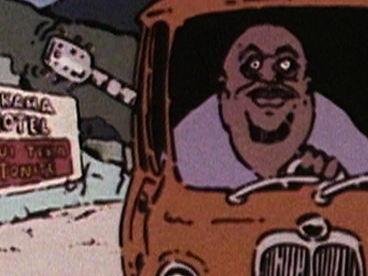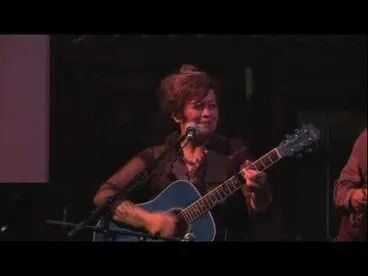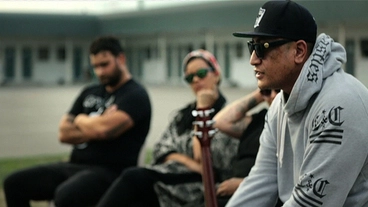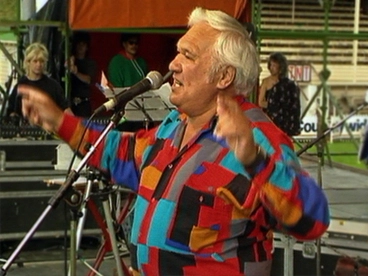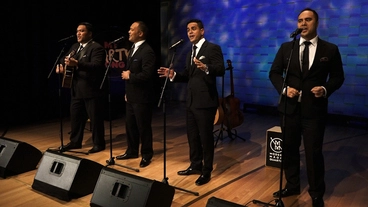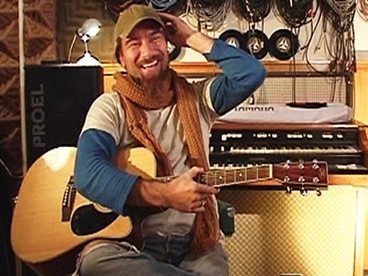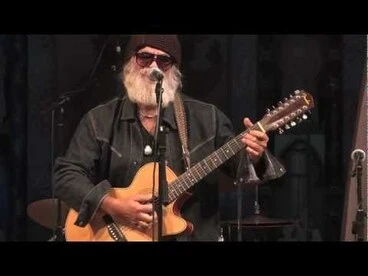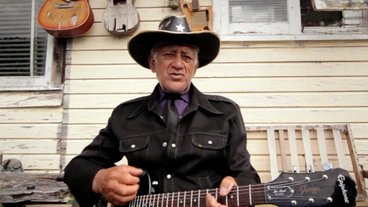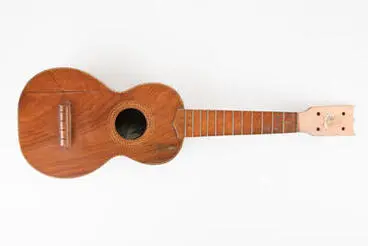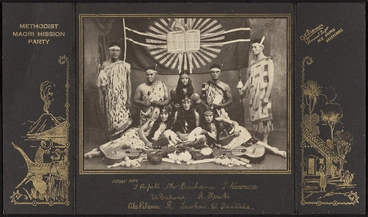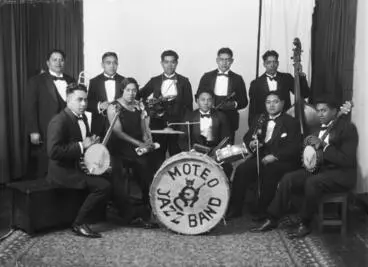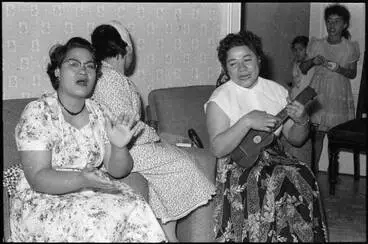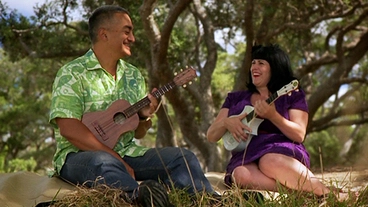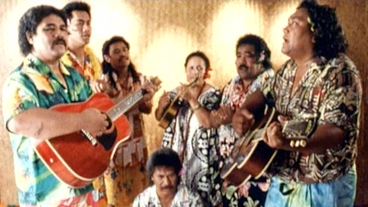No hea te Kitā Māori? Where did the ‘Māori Guitar’ come from?
A DigitalNZ Story by National Library Services to Schools
How did we get to the point where the guitar plays a central role in modern Maori performance? What other instruments were used as part of performances?
WHAKATAUKĪ
Kia kawea tātou e te rēhia
Let us be taken by the spirit of joy, of entertainment
This whakataukī (saying) indicates that performance-based entertainment was central to Māori society long before the first arrival of Europeans. Whare tapere was the name given to sites used for entertainments such as storytelling, dance, music and games. Sometimes this name referred to a special building, but more often a suitable outdoor location such as the base of a notable tree was designated a whare tapere.
Source: Māori theatre - te whare tapere hōu - Origins of Māori theatre, Te Ara - the Encyclopedia of New Zealand
INTRODUCED MUSICAL INSTRUMENTS
After European settlement, a number of factors led to the near-demise of use of taonga puoro (traditional Māori instruments). Many of the ceremonies at which they were played disappeared with the introduction of Christianity. Māori themselves put aside their traditional instruments in favour of introduced versions such as the jew’s harp, which replaced its equivalent, the rōria. Māori musicians were swift and adept at adopting a wide range of new instruments including banjos, pianos, bagpipes, brass-band instruments and, perhaps most popular of all, the guitar.
Source: Māori musical instruments – taonga puoro - Decline and revival of Māori instruments, Te Ara - the Encyclopedia of New Zealand
Photograph: Hamua Glee Party
Wairarapa Archive
Group of Maori performers, probably the Methodist Waiata Maori Choir
Alexander Turnbull Library
Maori musical group, Wanganui
Alexander Turnbull Library
Māori Agricultural College Band
MTG Hawke's Bay
Maori Kapa Haka performers
Museum of New Zealand Te Papa Tongarewa
Portrait of an unidentified Māori woman
MTG Hawke's Bay
⋆ GUITARS - (Te Ao Hou - No. 5 Spring 1953)
Alexander Turnbull Library
[Portrait of two military servicemen with guitar and saxophone]
Auckland War Memorial Museum Tāmaki Paenga Hira
They hear the school bus stop on the road. From the series: Washday at the pa
Museum of New Zealand Te Papa Tongarewa
Henare Gilbert singing and playing his guitar at his home in Stokes Valley
Alexander Turnbull Library
The Quin Tikis at the Māori Community Centre, Halsey Street, 1961
Auckland Libraries
Tui Teka and the Maori Volcanics
Manatū Taonga, the Ministry for Culture and Heritage
Māori Hi-Five band
Manatū Taonga, the Ministry for Culture and Heritage
Ngati Poneke Young Maori Club attends a party, Wellington
Alexander Turnbull Library
Maori Youth Club Christmas party, Whakatane
Alexander Turnbull Library
Summer and Winter it pays to send to LEW... - (Te Ao Hou - No. 15 July 1956)
Alexander Turnbull Library
Piko Rangitaawa
Puke Ariki
Inia Te Wiata (left) as a member of the Methodist Maori Mission choir
Alexander Turnbull Library
Scenes from Otukou Pa, next to lake Rotoaira
Alexander Turnbull Library
Aftermath of the opening of Hoani Waititi Marae, Glen Eden, Auckland
Alexander Turnbull Library
After the funeral of Inia Te Wiata, Raukawa Marae, Otaki
Alexander Turnbull Library
Maori Land March. Parliament.
Museum of New Zealand Te Papa Tongarewa
Four performers with guitar, Parihaka Concert
Auckland War Memorial Museum Tāmaki Paenga Hira
Golden Harvest
NZ On Screen
Principal playing guitar and singing with class
NZEI Te Riu Roa (New Zealand Educational Institute)
The Reggae Man
Manatū Taonga, the Ministry for Culture and Heritage
VIDEO
Mid 20th century Māori music
In the 1950s and 1960s action songs were made popular by Māori showbands and by other performers such as the Howard Morrison Quartet. During the Māori cultural renaissance, new clubs and culture groups were set up, and original songwriting was encouraged. Songwriters and singers such as Prince Tui Teka, Moana Maniapoto and Dalvanius Prime developed a Māori-influenced style, and used the Māori language. Ngoi Pēwhairangi wrote the hit songs ‘E ipo’ and ‘Poi e’.
Instruments
Early composers and performers often used the piano and violin. The guitar became dominant in the mid-20th century, and in the later 20th century taonga puoro (traditional Māori instruments) were revived.
Source: Waiata hōu – contemporary Māori songs, Te Ara - the Encyclopedia of New Zealand
Prince Tui Teka - 1983 Variety Show
NZ On Screen
Whirimako Black - LATE at the Museum
Auckland War Memorial Museum Tāmaki Paenga Hira
When the Haka Became Boogie
NZ On Screen
Holmes - Johnny 'The Māori Cowboy' Cooper
NZ On Screen
My Party Song - First Episode
NZ On Screen
Making Music - Warren Maxwell
NZ On Screen
Matariki 2011 Billy TK Senior
Museum of New Zealand Te Papa Tongarewa
Loading Docs 2014 - The Road to Whakarae
NZ On Screen
OTHER INSTRUMENTS
'Ukarere (Ukulele)
Museum of New Zealand Te Papa Tongarewa
'Ukarere (Ukulele)
Museum of New Zealand Te Papa Tongarewa
Ukulele
Auckland War Memorial Museum Tāmaki Paenga Hira
Maori girl playing a Jews Harp
Alexander Turnbull Library
Methodist Maori Mission Party
Auckland Libraries
Group on Kapiti Island
Alexander Turnbull Library
Group of school students from Ahipara School, playing musical instruments
Alexander Turnbull Library
Banjo player, probably Hosea Easton, at home of William and Lydia Williams, Carlyle Street, Napier
Alexander Turnbull Library
Unidentified group of Maori men with musical instruments
Alexander Turnbull Library
Ratana youth band, Wanganui
Alexander Turnbull Library
Moteo Jazz Band
MTG Hawke's Bay
Family gathering, 1959
Auckland Libraries
Bill Sevesi's Dream
NZ On Screen
SUPPORTING RESOURCES
A history of Aotearoa in seven musical instruments — here are some key themes in the history of Aotearoa New Zealand, traced through musical instruments.
Jingajik Guitar — Te Ahi Kaa explores the guitar.
Māori strumming pattern — Michael Brown interviewed Charles Royal on the dumdejak strum popular in Māori songs.
Michael Parekowhai: Ten Guitars — Parekowhai’s Ten Guitars project is based on the Engelbert Humperdinck song.
Ten guitars — Ten Guitars became the anthem of 1960s Maori who had suffered the dislocation of moving from back-country marae to the Big Smoke.
Ten Riffs on the Maori Strum —what is the most popular and enduring guitar style to have yet emerged from Aotearoa-New Zealand?
The Māori strum — the ‘boom-chucka-boom-chucka’ “Māori strum” turned a British song – Ten Guitars – into an unofficial Kiwi national anthem.
Students performing, Whatatutu Primary School, near Gisborne
Museum of New Zealand Te Papa Tongarewa
MAORI ENTERTAINERS. (Poverty Bay Herald, 04 February 1916)
National Library of New Zealand
Ohinemutu, Rotorua, 1964
Museum of New Zealand Te Papa Tongarewa
This story was curated and compiled by Te Puna Mātauranga o Aotearoa | National Library of New Zealand, Services to Schools staff, May 2019.
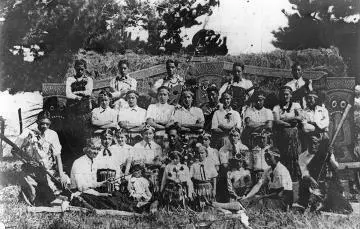
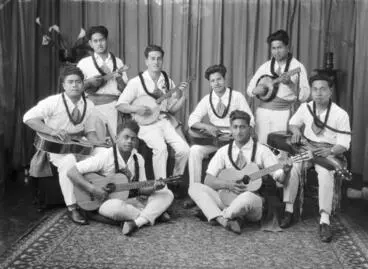
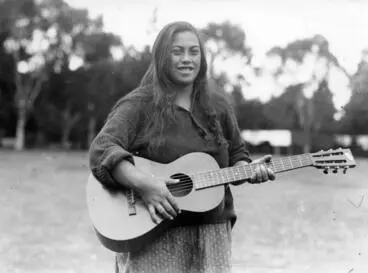

![[Portrait of two military servicemen with guitar and saxophone] Image: [Portrait of two military servicemen with guitar and saxophone]](https://thumbnailer.digitalnz.org/?resize=770x&src=https%3A%2F%2Fcollection-api.aucklandmuseum.com%2Frecords%2Fimages%2Fmedium%2F524314%2Fd59be806df3902fcca3d5515291db2e94278e38a.jpg&resize=368%253E)
